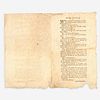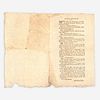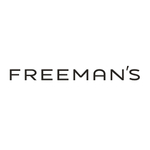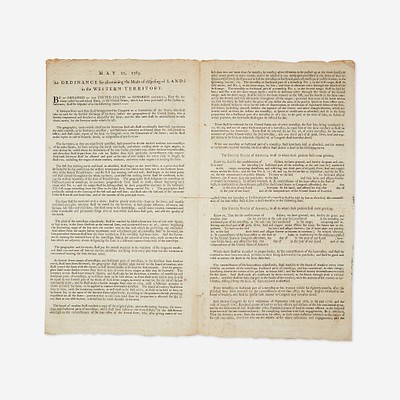[Americana] [Jefferson, Thomas, and John Adams] Printed 1796 Presidential Campaign Handbill
About Seller
2400 Market St
Philadelphia, PA 19147
United States
Established in 1805, Freeman’s Auction House holds tradition close, with a progressive mind-set towards marketing and promotion, along with access to a team of top experts in the auction business. And now with offices in New England, the Southeast, and on the West Coast, it has never been easier to ...Read more
Two ways to bid:
- Leave a max absentee bid and the platform will bid on your behalf up to your maximum bid during the live auction.
- Bid live during the auction and your bids will be submitted real-time to the auctioneer.
Bid Increments
| Price | Bid Increment |
|---|---|
| $0 | $25 |
| $500 | $50 |
| $1,000 | $100 |
| $2,000 | $200 |
| $3,000 | $250 |
| $5,000 | $500 |
| $10,000 | $1,000 |
| $20,000 | $2,000 |
| $30,000 | $2,500 |
| $50,000 | $5,000 |
| $100,000 | $10,000 |
About Auction
Feb 17, 2022
Freeman’s February 17 Books and Manuscripts auction is an Americana collector’s delight, with highlights led by an extremely rare Northwest Territory Land Ordinance from 1785. Curated by Darren WInston, Head of the Books and Manuscripts Department at Freeman's. Freeman's info@freemansauction.com
- Lot Description
[Americana] [Jefferson, Thomas, and John Adams] Printed 1796 Presidential Campaign Handbill
Extremely rare campaign handbill from the 1796 United States Presidential election, the first to feature emerging political parties
"Who drew the Declaration of Independence, that great Charter of our Enfranchisement? Answer--Thomas Jefferson"
No place, no date (Maryland, ca. November-December, 1796). Small bifolium sheet, 7 3/4 x 4 3/4 in. (197 x 121 mm). Printed campaign handbill; uncut sheet including another copy of same. Creasing from when folded; toned and lightly spotted; bottom edge worn; small open tear at fold on second leaf.
An extremely rare, and unrecorded, pro-Thomas Jefferson handbill from the 1796 presidential election. This was only the third presidential election in the history of the United States, and the first one to be contested by nascent political parties, the Democratic-Republicans and the Federalists. It was the first presidential election where partisan affiliation began to play a significant role, and it was the first to use campaigning tactics to influence voting, such as the printing of handbills and pamphlets such as this, and the use of party operatives to organize campaign strategy and voting drives. The election pitted former Secretary of State Thomas Jefferson against Vice President John Adams. It is the only presidential election that saw the president and vice president elected from opposing parties, with Adams elected president and Jefferson vice president.
This handbill takes the form of a catechism in support of Thomas Jefferson, featuring ten questions and ten answers. In the 1790s the catechistic format was often used as a pedagogical tool by political activists to teach voters to be partisans and party members, as it was a format familiar to most lay readers. The text highlights Jefferson's achievements as a statesman, politician, and defender of America from foreign influence, while casting Adams and his Federalist colleagues--specifically Alexander Hamilton--as monarchists and "miscreants." While the handbill is not dated, the contents of it, as well as its appearance in newspapers of the time, place its printing in the fall of 1796. References to various issues that were important in the 1796 election are mentioned, for example, in the fourth question, the Neutrality Proclamation of 1793; in the fifth question, the Genêt Affair; in the sixth question the trial of Gideon Henfield; in the seventh question, the 1791 Declaration of Pillnitz. Other issues are referred to--although not unique to the 1796 election, as they were also campaign issues in 1800--such as Thomas Jefferson's term as the governor of Virginia and his purported dereliction of duty during the American Revolution in the face of invading British troops, in question eight (the first public charge of cowardice by Jefferson was made by Virginia lawyer Charles Simms in September 1796), and Adams's and Hamilton's supposed support of monarchy and hereditary government in the last question (stemming from Adams's Defence of the Constitutions of the Government of the United States of America in 1787, and Hamilton's June 18, 1787 speech at the Constitutional Convention).
In The First Presidential Contest: 1796 and the Founding of American Democracy, historian Jeffrey L. Pasley writes, "One of the most economical and effective pro-Jefferson texts produced anywhere in 1796 came out of the Eastern Shore town of Easton [Maryland]. This was a catechism that succinctly taught the gospel of Thomas Jefferson as it would be passed down for generations, starting with the sacred text (Declaration of Independence) that up until this time had been only sporadically presented as a national mission statement and had not even been widely credited to Jefferson." Pasley locates four newspapers throughout the country that reprinted the text of this handbill: the first appearing in Easton in James Cowan's Maryland Herald and Eastern Shore Intelligencer, on November 8, 1796; followed by the Washington Spy, November 30, 1796; the Charleston City Gazette, December 3, 1796; the Portsmouth New Hampshire Gazette, December 10, 1796. We have found an additional printing in the Philadelphia Aurora General Advertiser, Friday November 18, 1796, the de facto national paper for the Democratic-Republican press that supported Jefferson. One noticeable difference between all of these published versions and the handbill is that Alexander Hamilton's last name is misspelled "Hambleton" in the handbill.
This handbill was discovered in a residence on Ripley Plantation, located near Church Hill, Queen Anne's County, Maryland, 30 miles north of Easton where the text first appeared in the Maryland Herald and Eastern Shore Intelligencer. The grounds of the plantation have been in the same family since the 17th-century, and the home where it was found dates to the very early 19th-century, it was demolished in 2021.
This handbill is the only known surviving example of its kind, and until now the text has only survived in newspaper printings like the above. Although it would have been distributed by hand, the fact that this example is an uncut printing of two leads us to believe it was never circulated.
Background
The election of 1796 was the first great test of the presidential succession system for the young nation. The first two presidential elections, in 1788 and 1792, saw George Washington elected without competition but by the end of 1796 the political climate in the country had dramatically changed. The country's first political parties were beginning to emerge on a national scale due largely to reactions to events that occurred during Washington's two terms. Points of contention developed around his administration's fiscal policies, orchestrated by Secretary of the Treasury, Alexander Hamilton. The passage of the Jay Treaty in 1794 with Great Britain, his administration's neutrality with France after the outbreak of the French Revolution, and France's subsequent wars with European monarchies, were key points creating wider partisan divide. As a result, New England-based Federalists, largely in support of these foreign and domestic policies, organized against the largely southern-based Democratic-Republicans, who were against these fiscal measures and viewed the Jay Treaty with disdain and sought closer ties with France. Up until two months before the November election neither group was entirely sure whether Washington would seek a third term, but this definitively changed on September 19, 1796, when his Farewell Address was printed in Philadelphia’s American Daily Advertiser. Written with the assistance of Hamilton and congressman James Madison, Washington's address warned against foreign alliances, domestic regionalism, and political partisanship, and urged the American people to stay united for the sake of the Union's perpetuity. His announcement made it certain that the upcoming presidential election would be the first nationally competitive contest in the history of the country, but his warnings against factionalism fell on deaf ears. The Federalists rallied around Vice President John Adams as their candidate of choice, while Democratic-Republicans rallied around former Secretary of State Thomas Jefferson. At this time neither Adams nor Jefferson campaigned themselves, as it was deemed politically improper, so campaigning was left to a newly organizing group of partisan operatives. Partisan mudslinging was immediate and increasingly bitter during the short campaign as newspaper articles, pamphlets, and handbills, often painted the candidates in stark and unflattering terms. Jefferson was often vilified by Federalist-aligned operatives as a Francophile, atheist, and coward, while Adams was accused by Democratic-Republicans of being an Anglophile and a monarchist who secretly wished to establish a family dynasty. Campaigning was so widespread, emotionally charged, and novel for the period, that it came as a shock to Adams's wife, Abigail. She wrote in a November 11 letter to her son John Quincy (two days after the first newspaper appearance of this handbill's text), "...the News papers inform us that the most active measures are taking by the Democratic Societies to ensure success to their Candidate, by circulating Hand Bill containing libels on mr Adams. Gate post, Doors of Houses & posts are coverd through the Country, a right Gallic measure. Men are hired to ride through the Country with Bags of these Hand Bills. I do not however learn that they contain any thing but to represent him as attach’d to Monarchy to Tittles &c that he is Enemical to the Rights of the people, all of which these very engines of Mischief know to be false." Handbills condemning Adams had begun to appear in Boston as early as September 24, but were most frequently found in the battleground state of Pennsylvania, which was inundated with printed campaign matter on a scale never seen before.
Maryland was a battleground state during this election as it occupied a unique borderline position between the Northern and Southern sectional lines, and with ten electoral votes, it was a key state to help determine the contest. Their election process at the time saw eligible voters (landowning men) choose electors by popular vote, organized by district, with the winning electors then voting for their presidential candidate of choice. Maryland was one of only seven states to hold popular elections like this at the time. The state legislatures in the other nine states directly chose their electors. Federalists and Democratic-Republicans both organized campaign efforts in Baltimore, Annapolis, and throughout the countryside in order to sway eligible voters to choose their elector candidate, with elector elections occurring from November 9-12. It was common at the time for elector candidates in rural areas in Maryland to campaign on their own behalf to their neighbors and people within their district, often through various means of persuasion, and sometimes, coercion. Maryland had its own partisan operatives campaigning on behalf of their candidate of choice. Adams protégé and Federalist congressman William Vans Murray of the eighth district swayed voters with his Short Vindication, a written defense of Adams's Defence of the American Constitutions. Conversely, Jefferson elector candidate, Gabriel Duvall, rode through the Maryland countryside near Annapolis, sounding the alarm about Adams's monarchical sympathies, using Adams's Defence as evidence, to anyone that would listen. This handbill was presumably one of many handed out by partisan operatives, supporters, or a local elector, in or near Talbot County, Queen's Anne County, and the surrounding area, sometime before the elector-elections in early November, or on December 7, 1796, when the winning electors met to cast their vote for the presidency. It is also possible that this was handed out at a polling place in those areas. Talbot County and Queen Anne's County both fell within Maryland's eighth district, and saw Federalist-aligned elector candidate John Roberts run against Democratic-Republican-aligned Robert Wright. The election saw the state split their vote, with Adams winning seven electoral votes, Jefferson four, and the remaining nine split amongst other candidates. Roberts won Talbot County for Adams, where the text first appeared in newspaper form, while Wright won Queen Anne's County for Jefferson, where this handbill was discovered. Ultimately the election was settled by the thinnest of margins and saw Adams ascend to the presidency with 71 total electoral votes, one more electoral vote than needed to achieve a majority. Jefferson came in second place with 68 votes, and, through a quirk in the electoral rules of the day, was elected vice president.
Any surviving handbills from this election are rare.
- Shipping Info
-
No lot may be removed from Freeman’s premises until the buyer has paid in full the purchase price therefor including Buyer’s Premium or has satisfied such terms that Freeman’s, in its sole discretion, shall require. Subject to the foregoing, all Property shall be paid for and removed by the buyer at his/ her expense within ten (10) days of sale and, if not so removed, may be sold by Freeman’s, or sent by Freeman’s to a third-party storage facility, at the sole risk and charge of the buyer(s), and Freeman’s may prohibit the buyer from participating, directly or indirectly, as a bidder or buyer in any future sale or sales. In addition to other remedies available to Freeman’s by law, Freeman’s reserves the right to impose a late charge of 1.5% per month of the total purchase price on any balance remaining ten (10) days after the day of sale. If Property is not removed by the buyer within ten (10) days, a handling charge of 2% of the total purchase price per month from the tenth day after the sale until removal by the buyer shall be payable to Freeman’s by the buyer. Freeman’s will not be responsible for any loss, damage, theft, or otherwise responsible for any goods left in Freeman’s possession after ten (10) days. If the foregoing conditions or any applicable provisions of law are not complied with, in addition to other remedies available to Freeman’s and the Consignor (including without limitation the right to hold the buyer(s) liable for the bid price) Freeman’s, at its option, may either cancel the sale, retaining as liquidated damages all payments made by the buyer(s), or resell the property. In such event, the buyer(s) shall remain liable for any deficiency in the original purchase price and will also be responsible for all costs, including warehousing, the expense of the ultimate sale, and Freeman’s commission at its regular rates together with all related and incidental charges, including legal fees. Payment is a precondition to removal. Payment shall be by cash, certified check or similar bank draft, or any other method approved by Freeman’s. Checks will not be deemed to constitute payment until cleared. Any exceptions must be made upon Freeman’s written approval of credit prior to sale. In addition, a defaulting buyer will be deemed to have granted and assigned to Freeman’s, a continuing security interest of first priority in any property or money of, or owing to such buyer in Freeman’ possession, and Freeman’s may retain and apply such property or money as collateral security for the obligations due to Freeman’s. Freeman’s shall have all of the rights accorded a secured party under the Pennsylvania Uniform Commercial Code.
-
- Buyer's Premium



 EUR
EUR CAD
CAD AUD
AUD GBP
GBP MXN
MXN HKD
HKD CNY
CNY MYR
MYR SEK
SEK SGD
SGD CHF
CHF THB
THB![[Americana] [Jefferson, Thomas, and John Adams] Printed 1796 Presidential Campaign Handbill](https://s1.img.bidsquare.com/item/l/1094/10945502.jpeg?t=1NcmVr)
![[Americana] [Jefferson, Thomas, and John Adams] Printed 1796 Presidential Campaign Handbill](https://s1.img.bidsquare.com/item/s/1094/10945502.jpeg?t=1NcmVr)












